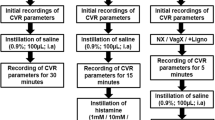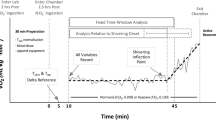Abstract
Body temperature homeostasis in higher vertebrates is achieved by modulation of thermoregulatory effector mechanisms such as shivering, panting or changes in local vascular tone. Regional cardiovascular control by differentiation of the sympathetic outflow represents a well characterized concept to maintain body temperature homeostasis under conditions of physiological disturbances within the thermoregulatory control circuit (1). Peripheral warming leads to a fall in cutaneous sympathetic nerve activity in conscious rabbits, thus reducing vasomotor tone, whereas visceral and cardiac sympathetic activity increases (1,2). Respiratory frequency and evaporative water loss (REWL) are augmented to allow sufficient heat dissipation at unaltered mean arterial pressure and heart rate, and low rates of metabolic heat production (3). Peripheral cold stimuli produce the reverse pattern of autonomic effector activities. Cutaneous vasodilation occurring during heat exposure requires active neurogenic vasodilation in addition to the release of vasoconstrictor tone. Besides vasoactive intestinal polypeptide (VIP) and ATP, gaseous nitric oxide (NO) might represent one of the mediators involved in nonadrenergic, noncholinergic (NANC) transmission processes (4). NO endogenously derived from the amino acid L-arginine through enzymatic activity of nitric oxide synthase (NOS) isoforms represents a rather novel concept of intercellular signalling (5). Synthesized by vascular endothelial cells, smooth muscle cells and neurons, NO appears to activate soluble intracellular guanylate cyclase activity in a paracrine fashion, finally leading to NANC vaso- or bronchodilation and alteration of neuronal activity, respectively. With regard to its possible role within autonomic regulatory circuits to maintain homeostasis, only scarce information is available (5).
Access this chapter
Tax calculation will be finalised at checkout
Purchases are for personal use only
Preview
Unable to display preview. Download preview PDF.
Similar content being viewed by others
References
Iriki, M, Simon, E (1978): Regional differentiation of sympathetic efferents. In: Integrative control functions of the brain, Vol. 1. Ito, M, Tsukahara, N, Kubota, K, Yagi, K eds. Tokyo, Kodansha Ltd., Elsevier Biomedical Press, 221–238.
Riedel, W, Kozawa, E, Iriki, M (1982): Renal and cutaneous vasomotor and respiratory rate adjustments to peripheral cold and warm stimuli and to bacterial endotoxin in conscious rabbits. J Aut Nerv sys 5, 177–194.
Keil, R, Gerstberger, R, Simon, E (1994): Hypothalamic thermal stimulation modulates vasopressin release in hyperosmotically stimulated rabbits. Am J Physiol (submitted).
Taylor, F, Bishop, VS (1993): A role for nitric oxide in active thermoregulatory vasodilation. Am J Physiol 264, H1355–H1359.
Moncada, S, Higgs, A (1993): The L-arginine-nitric oxide pathway. New Engl J Med 329, 2002–2012.
Gerstberger, R, Keil, R, Jurzak, M, Hjelmqvist, H, Eriksson, S (1994): Hormonal and hemodynamic effects of NOS inhibition in the conscious sheep and rabbit. In: Biology of nitric oxide. Moncada, S, Feelisch, M, Busse, R, Higgs, EA eds. Colchester, Portland Press (in press).
Khan, F, Palacino, JJ, Coffman, JD, Cohen, RA (1993): Chronic inhibition of nitric oxide production augments skin vasoconstriction in the rabbit ear. J Cardiovasc Pharmacol 22, 280–286.
Van Gelderen, EM, Den Boer, MO, Saxena, PR (1993): NG-nitro-L-arginine methyl ester: systemic and pulmonary haemodynamic, tissue blood flow and arteriovenous shunting in the pig. NS Arch Pharmacol 348, 417–423.
Du, Z-Y, Dusting, GJ, Woodman, OL (1992): Baroreceptor reflexes and vascular reactivity during inhibition of nitric oxide synthesis in conscious rabbits. Eur J Pharmacol 214, 21–26.
Sigmon, DH, Carretero, OA, Beierwaltes WH (1993): Renal versus femoral hemodynamic response to endothelium-derived relaxing factor synthesis inhibition. J Vasc Res 30, 218–223.
Vizzard, MA, Erdman, SL, Erickson, VL, Stewart, RJ, Roppolo, JR, Degroat, WC (1994): Localization of NADPH diaphorase in the lumbosacral spinal cord and dorsal root ganglia of the cat. J Comp Neurol 339, 62–75.
Kumagai, H., Averill, DB, Khosla, MC, Ferrario, CM (1993): Role of nitric oxide and angiotensin II in the regulation of sympathetic nerve activity in spontaneously hypertensive rats. Hypertension 21, 476–484.
Author information
Authors and Affiliations
Editor information
Editors and Affiliations
Rights and permissions
Copyright information
© 1994 Birkhäuser Verlag Basel
About this chapter
Cite this chapter
Gerstberger, R., Hjelmqvist, H., Keil, R. (1994). Nitric Oxide Modulates Thermoregulatory Effector Mechanisms in the Conscious Rabbit. In: Zeisberger, E., Schönbaum, E., Lomax, P. (eds) Thermal Balance in Health and Disease. APS Advances in Pharmacological Sciences. Birkhäuser Basel. https://doi.org/10.1007/978-3-0348-7429-8_69
Download citation
DOI: https://doi.org/10.1007/978-3-0348-7429-8_69
Publisher Name: Birkhäuser Basel
Print ISBN: 978-3-0348-7431-1
Online ISBN: 978-3-0348-7429-8
eBook Packages: Springer Book Archive




